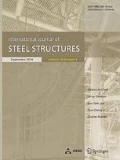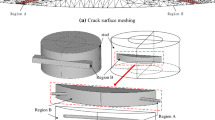Abstract
The fatigue fracture of the stud connector is the main failure mode of the steel–concrete composite structure. Fatigue assessment of cracked stud connectors with weld details is conducted in this study by using the linear elastic fracture mechanics approach. The mixed-mode stress intensity factor is calculated by the M-integral method, and the relative crack position hc is considered. First, a 3D finite element model of the push-out test with stud welding details is proposed in this study, and the load–slip curve and stress distribution of the stud connector were analyzed. Then, the mixed-mode stress intensity factor was calculated by defining the sub-model with cracks, and the influence coefficient of the mixed-mode stress intensity factor was investigated. The important influencing parameters, which include the crack aspect ratio, relative crack height, stud diameter, and stud height, are combined for calculation. The mixed-mode stress intensity factor of the stud is dominated by mode I (open). The influence of the stud height is not observed. However, the stress intensity factor of the crack tip gradually increases with the stud diameter. The study also found the influence of the crack shape under various conditions. The results of this study can be used by researchers to evaluate the fatigue fracture conditions of stud connectors.



















Similar content being viewed by others
References
Chandrasekaran, S. (2019). Advanced steel design of structures. CRC Press.
Chinese Standard, G. (2010). 50010, code for design of concrete structures. GB50010-2010. China Building Industry Press.
Choi, E., Mohammadzadeh, B., Hwang, J.-H., Kim, W. J. J. C., & Materials, B. (2018a). Pullout behavior of superelastic SMA fibers with various end-shapes embedded in cement mortar. Construction and Building Materials, 167, 605–616.
Choi, E., Mohammadzadeh, B., Kim, D., & Jeon, J.-S.J.C.P.B.E. (2018b). A new experimental investigation into the effects of reinforcing mortar beams with superelastic SMA fibers on controlling and closing cracks. Composites Part B: Engineering, 137, 140–152.
Choi, E., Mohammadzadeh, B., & Kim, H. S. (2019). SMA bending bars as self-centering and damping devices. Smart Materials and Structures., 28(2), 025029.
Correia, J., Carvalho, H., Lesiuk, G., Mourão, A., Grilo, L. F., de Jesus, A., et al. (2020). Fatigue crack growth modelling of Fão Bridge puddle iron under variable amplitude loading. International Journal of Fatigue., 136, 105588.
da Silva, A. L., Correia, J. A., de Jesus, A. M., Figueiredo, M. A., Pedrosa, B. A., Fernandes, A. A., et al. (2019a). Fatigue characterization of a beam-to-column riveted joint. Engineering Failure Analysis, 103, 95–123.
da Silva, A. L., Correia, J. A., de Jesus, A. M., Lesiuk, G., Fernandes, A. A., Calcada, R., et al. (2019b). Influence of fillet end geometry on fatigue behaviour of welded joints. International Journal of Fatigue, 123, 196–212.
Han, Q. H., Yang, G., Xu, J., Wang, Y. H. J. S., & Structures, C. (2017). Fatigue analysis of crumble rubber concrete-steel composite beams based on XFEM. Steel and Composite Structures, 25(1), 57–65.
Hanswille, G., Porsch, M., & Ustundag, C. (2007). Resistance of headed studs subjected to fatigue loading. Journal of Constructional Steel Research, 63(4), 475–484. https://doi.org/10.1016/j.jcsr.2006.06.035
Kotousov, A., Khanna, A., Branco, R., De Jesus, A. M., & Correia, J. A. (2019). Review of current progress in 3D linear elastic fracture mechanics. Mechanical Fatigue of Metals (pp. 125–131). Springer.
Kozma, A., Odenbreit, C., Braun, M. V., Veljkovic, M., & Nijgh, M. P. (2019). Push-out tests on demountable shear connectors of steel-concrete composite structures. Structures, 21, 45–54. https://doi.org/10.1016/j.istruc.2019.05.011
Lee, P.-G., Shim, C.-S., & Chang, S.-P. (2005). Static and fatigue behavior of large stud shear connectors for steel–concrete composite bridges. Journal of Constructional Steel Research, 61(9), 1270–1285. https://doi.org/10.1016/j.jcsr.2005.01.007
Lesiuk, G., Smolnicki, M., Rozumek, D., Krechkovska, H., Student, O., Correia, J., et al. (2020). Study of the fatigue crack growth in long-term operated mild steel under mixed-mode (I+ II, I+ III) loading conditions. Materials, 13(1), 160.
Li, C.-Q., Fu, G., & Yang, W. (2016). Stress intensity factors for inclined external surface cracks in pressurised pipes. Engineering Fracture Mechanics, 165, 72–86. https://doi.org/10.1016/j.engfracmech.2016.08.014
Liu, Y., Chen, F., Lu, N., Wang, L., & Wang, B. (2019). Fatigue performance of rib-to-deck double-side welded joints in orthotropic steel decks. Engineering Failure Analysis, 105, 127–142. https://doi.org/10.1016/j.engfailanal.2019.07.015
Liu, Y., Chen, F., Wang, D., & Lu, N. (2020). Fatigue crack growth behavior of rib-to-deck double-sided welded joints of orthotropic steel decks. Advances in Structural Engineering. https://doi.org/10.1177/1369433220961757
Mohammadzadeh, B., Choi, E., & Kim, W. J. J. S. E. M. (2018). Comprehensive investigation of buckling behavior of plates considering effects of holes. Structural Engineering and Mechanics, 68(2), 261–275.
Mohammadzadeh, B., & Noh, H. C. (2017). Analytical method to investigate nonlinear dynamic responses of sandwich plates with FGM faces resting on elastic foundation considering blast loads. Composite Structures, 174, 142–157.
Mohammadzadeh, B., & Noh, H. C. (2019). An analytical and numerical investigation on the dynamic responses of steel plates considering the blast loads. International Journal of Steel Structures, 19(2), 603–617.
Nguyen, H. T., & Kim, S. E. (2009). Finite element modeling of push-out tests for large stud shear connectors. Journal of Constructional Steel Research, 65(10–11), 1909–1920. https://doi.org/10.1016/j.jcsr.2009.06.010
Oehlers, D. J., & Bradford, M. A. (2013). Composite steel and concrete structures: Fundamental behaviour: Fundamental behaviour. Elsevier.
Ovuoba, B., & Prinz, G. S. (2018). Investigation of residual fatigue life in shear studs of existing composite bridge girders following decades of traffic loading. Engineering Structures, 161, 134–145. https://doi.org/10.1016/j.engstruct.2018.02.018
Raju, I., & Newman Jr, J. (1982a). Stress-intensity factors for internal and external surface cracks in cylindrical vessels.
Raju, I., & Newman, J. J. E., Jr. (1979). Stress-intensity factors for a wide range of semi-elliptical surface cracks in finite-thickness plates. Engineering Fracture Mechanics, 11(4), 817–829.
Raju, I. S., & Newman, J. C., Jr. (1982b). Stress-intensity factors for internal and external surface cracks in cylindrical vessels. Journal of Pressure Vessel Technology, 104(4), 293–298. https://doi.org/10.1115/1.3264220
Rama, T., & Gnanasekar, N. (2019). Investigation of the effect of load distribution along the face width and load sharing between the pairs in contact on the fracture parameters of the spur gear tooth with root crack. Engineering Failure Analysis, 97, 518–533. https://doi.org/10.1016/j.engfailanal.2019.01.051
Rice, J. R. (1968). A path independent integral and the approximate analysis of strain concentration by notches and cracks.
Silva, A., De Jesus, A., Xavier, J., Correia, J., & Fernandes, A. J. E. F. M. (2017). Combined analytical-numerical methodologies for the evaluation of mixed-mode (I+ II) fatigue crack growth rates in structural steels. Engineering Fracture Mechanics, 185, 124–138.
Song, A., Wan, S., Jiang, Z., & Xu, J. (2018). Residual deflection analysis in negative moment regions of steel-concrete composite beams under fatigue loading. Construction and Building Materials, 158, 50–60. https://doi.org/10.1016/j.conbuildmat.2017.09.075
Standard, B. J. L., UK: BSI Stand Publ. (2015). BS 7910: 2013+ A1: 2015 Guide to methods for assessing the acceptability of flaws in metallic structures.
Wang, B., Huang, Q., & Liu, X. (2018a). Comparison of static and fatigue behaviors between stud and perfobond shear connectors. KSCE Journal of Civil Engineering, 23(1), 217–227. https://doi.org/10.1007/s12205-018-1303-0
Wang, B., Nagy, W., De Backer, H., & Chen, A. (2019). Fatigue process of rib-to-deck welded joints of orthotropic steel decks. Theoretical and Applied Fracture Mechanics, 101, 113–126. https://doi.org/10.1016/j.tafmec.2019.02.015
Wang, D., Liu, Y., & Liu, Y. (2018b). 3D temperature gradient effect on a steel-concrete composite deck in a suspension bridge with field monitoring data. Structural Control and Health Monitoring. https://doi.org/10.1002/stc.2179
Wang, J., Jivkov, A. P., Engelberg, D. L., & Li, Q. J. P. S. I. (2018c). Meso-scale modelling of mechanical behaviour and damage evolution in normal strength concrete. Procedia Structural Integrity, 13, 560–565.
Xin, H., Correia, J. A., & Veljkovic, M. J. E. S. (2021). Three-dimensional fatigue crack propagation simulation using extended finite element methods for steel grades S355 and S690 considering mean stress effects. Engineering Structures, 227, 111414.
Xu, J., Sun, H., Xie, Z., & Sun, J. (2019). Fatigue behaviour study of the shear stud using crack box technology and M integral method. International Journal of Steel Structures, 19(4), 1249–1259. https://doi.org/10.1007/s13296-019-00205-7
Xu, X., & Liu, Y. (2016). Analytical and numerical study of the shear stiffness of rubber-sleeved stud. Journal of Constructional Steel Research, 123, 68–78. https://doi.org/10.1016/j.jcsr.2016.04.020
Xu, X., Zhou, X., & Liu, Y. (2020). Behavior of rubber-sleeved stud shear connectors under fatigue loading. Construction and Building Materials. https://doi.org/10.1016/j.conbuildmat.2020.118386
Yau, J. F., Wang, S. S., & Corten, H. T. (1980). A mixed-mode crack analysis of isotropic solids using conservation laws of elasticity. Journal of Applied Mechanics, 47(2), 335–341. https://doi.org/10.1115/1.3153665
Yu-Hang, W., Jian-Guo, N., & Jian-Jun, L. (2014). Study on fatigue property of steel–concrete composite beams and studs. Journal of Constructional Steel Research, 94, 1–10. https://doi.org/10.1016/j.jcsr.2013.11.004
Zhuang, B., & Liu, Y. (2019). Study on the composite mechanism of large Rubber-Sleeved Stud connector. Construction and Building Materials, 211, 869–884. https://doi.org/10.1016/j.conbuildmat.2019.03.303
Acknowledgements
The research described in this paper was financially supported by the National Natural Science Foundation of China (Grant No. 51878072), and the Graduate Student Research Innovation Project of Hunan Province (CSUST) (Grant Nos. CX20200844, CX20190661).
Author information
Authors and Affiliations
Corresponding author
Additional information
Publisher's Note
Springer Nature remains neutral with regard to jurisdictional claims in published maps and institutional affiliations.
Rights and permissions
About this article
Cite this article
Wang, D., Tan, B., Wang, L. et al. Numerical Study on Stress Intensity Factors for Stud Connectors of Steel–Concrete Connection. Int J Steel Struct 21, 1775–1789 (2021). https://doi.org/10.1007/s13296-021-00534-6
Received:
Accepted:
Published:
Issue Date:
DOI: https://doi.org/10.1007/s13296-021-00534-6




